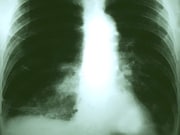Model relies on CT features, demographics, clinical data, and improves on current methods
THURSDAY, March 14, 2019 (HealthDay News) — The Lung Cancer Causal Model (LCCM) shows promise as a predictor of cancerous lung nodules, according to a study published online March 12 in Thorax.
Vineet K. Raghu, from the University of Pittsburgh, and colleagues used demographic and clinical data as well as low-dose computed tomography (LDCT) features for 92 individuals (training cohort) participating in the Pittsburgh Lung Screening cohort. The authors sought to develop an efficient predictor of early lung cancer, which was validated in a separate cohort of 126 individuals.
The researchers found that probabilistic graphical models identified three variables causally linked to malignant nodules and the largest benign nodule and integrated them to build the LCCM. Malignant nodules were discriminated from benign nodules based on nodule and vessel numbers and years since quitting smoking. The LCCM was found to improve cancer detection over existing methods, including the Brock parsimonious model. The number of surrounding vessels, which has not previously been used in predictive models, significantly improved predictive efficiency.
“LCCM is able to identify 30 percent of the benign nodules without risk of misclassifying,” the authors write.
Copyright © 2019 HealthDay. All rights reserved.








